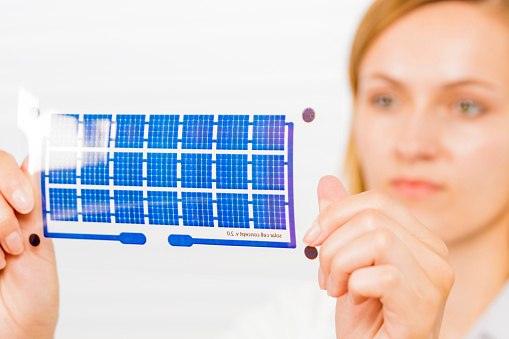Printed Electronic Materials

Printed electronics involves the production of ultra-thin, lightweight, flexible, large-area electronics using printing technology. It directly integrates electronic components in the printing process. Examples include thin-film transistors (TFTs), organic light emitting diodes (OLEDs), sensors, flexible displays, solar cells, and other energy harvesters, radio-frequency identification (RFID) tags, batteries and other energy storage materials. Printed electronics is a rapidly growing research area, finding applications in the automotive industry, consumer electronics, smart buildings, smart packaging, healthcare, and the Internet of Things (IoTs).
We offer a wide range of printable inks and substrates as building blocks of electronic printed devices.
Products
Popular Filters
Products
Printable Inks
Our printable inks have specific rheological properties and can be divided into three main categories: conductors, semiconductors, and dielectric materials. Deposition techniques for patterning these colloidal ink solutions enable structures with desired thickness and resolution in inkjet printing, screen printing, gravure printing, slot-die printing, aerosol jet printing and others. Each technique requires the proper tuning of a set of different ink parameters, such as viscosity, surface tension, conductivity, and compatibility of the solvents with the underlying materials to enable a consistent printing process.
Conductive Inks
Our conductive inks are the main building block of all printed electronic devices, providing the fundamental device structure and integrated circuit interconnects. We offer metal nanoparticle and microparticle inks for various type of printing techniques:
- Silver (Ag) inks with good physical properties and electrical conductivities
- Gold (Au), platinum (Pt), copper (Cu) and nickel (Ni) inks preferred for electrochemical sensors, batteries and fuel cells
- Flexible and biocompatible conducting polymer inks essential for bioelectronics
- Well characterized carbon nanomaterial inks, with large surface area, low defect, high chemical stability, and mechanical flexible, attractive for electrode materials in printed batteries, supercapacitors, stretchable bioelectronics, and wearable sensors
Semiconductor Inks
Semiconductor inks are the core component of printed electronic devices and largely determine the performance of the final device. We offer a broad selection of both conventional organic and inorganic semiconductor inks, and next generation two-dimensional material inks:
- Inorganic metal oxide ink, and organic semiconductor inks offer consistent properties such as mobility and bandgap, providing reliable performance for printed Organic Light Emitting Diode (OLED), Field Effect Transistors (FET), and Organic Solar Cells (OSCs) devices
- Emerging 2D nanomaterial inks offer direct bandgap, low defect, ease of fabrication, and the opportunity to fabricate novel, vertically-integrated next-generation electronic devices
Dielectric Inks
Dielectric inks and coatings play an important role in protecting and enhancing the operation of conductive materials, completing energy storage devices, and enabling electronic devices that operate under a bias voltage. Our dielectric inks are composed of organic polymers or ceramics in solvents and novel insulating 2D nanomaterials, such as hexagonal boron nitride, to provide temperature and electrochemical stability, which are important for solid state batteries, field effect transistors, and neuromorphic devices.
Substrates
Operating temperature range, roughness, mechanical property, transparency, and suitable wettability are important parameters to consider when selecting a substrate. A surface treatment process with proper chemicals typically helps to improve the wettability of the substrate with selected inks. We offer a range of conducting substrates coated with Indium Tin Oxide (ITO) or Fluorine-doped Tin Oxide (FTO), either on glass or flexible plastics, available in various substrate thicknesses and surface resistivities.
Related Resources
- Article: Inkjet Printing for Printed Electronics
Inkjet printing is one of the key enabling technologies of printed electronics. Inkjet printing technology classification, aspects of materials (inks, substrates) and respective pre-and post-processing steps are discussed.
- Article: Reactive Silver Inks for High-Performance Printed Electronics
The ability to pattern conductive electrodes is technologically relevant for several applications, including photovolatics, displays, sensors, and biomedical devices.
- Article: Graphene Inks for Printed Electronics
The emerging field of printed electronics requires a suite of functional materials for applications including flexible and large-area displays, radio frequency identification tags, portable energy harvesting and storage, biomedical and environmental sensor arrays, and logic circuits.
- Article: Inorganic Interface Layer Inks for Organic Electronic Applications
Find advantages of inorganic interface layer inks for organic electronic & other applications.
- Article: Conducting Polymer Materials for Flexible OPV Applications: Orgacon™ PEDOT : PSS
A detailed article on conducting polymer materials for flexible organic photovoltaics (OPVs) applications.
- Brochure: Organic & Printed Electronics: Innovative Materials and Resources for Your Research
Aldrich Materials Science is committed to providing a wide range of organic semiconducting products for use in high performance devices (OPVs, OLEDs and OTFTs) to support academic research through to industrial manufacturing.
- Article: Plexcore® OC Hole Injection Inks
Plexcore® organic conductive inks are electronic grade inks formulated for use in the hole injection layers of OLEDs.
- Brochure: Electronic Inks
Maximize performance with our electronic inks while minimizing your environmental footprint with printable materials.
To continue reading please sign in or create an account.
Don't Have An Account?